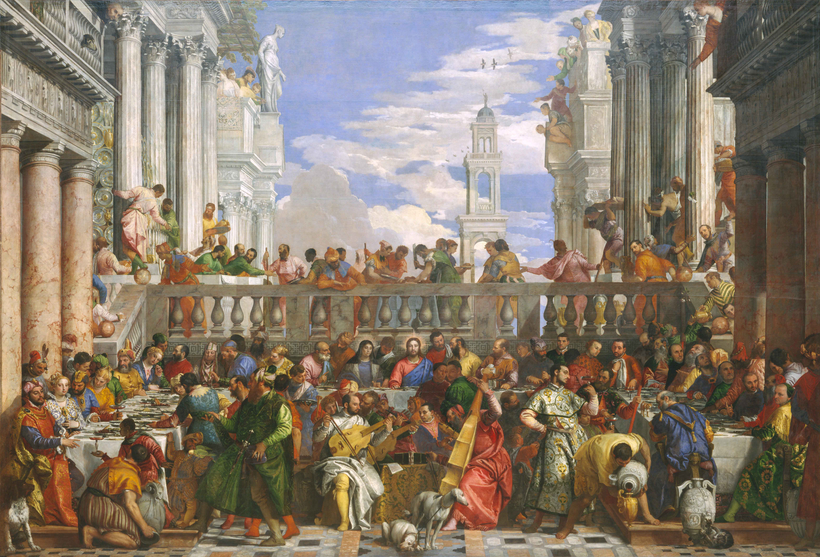“A wonder of the world,” wrote the artist Giacomo Barri in 1671 of Paolo Veronese’s The Wedding Feast at Cana, “and whosoever comes to Venice and departs without a sight of the Picture may be said to have seen nothing.” The enormous wall painting (approximately 22 feet by 32 feet) is set not, as the Bible would have it, in Galilee, but boldly in a late-Renaissance Venice, portraying 130 life-size figures—courtiers, musicians, soldiers, and a variety of animals—milling about an ornate marble terrace in lavish costumes. The entire scene of Venetian society’s bacchanalian decadence is drenched in vivid colors beneath a lapis lazuli sky, a stunning testament to the artist’s mastery of oil paint.
When, in 1562, the Benedictine abbot Girolamo Scrocchetto commissioned the work—which depicts the biblical scene of Christ performing his first miracle, turning water to wine—for the new refectory at the monastery of San Giorgio Maggiore, he made it clear to Veronese that the painting was not only to rival but to transcend Leonardo da Vinci’s The Last Supper, in Milan. When Veronese completed the job a year later, he delivered a tour de force. “This is not painting, this is magic,” wrote another awed 17th-century artist.
“He can make a single brushstroke of white read as a ribbon, a lock of hair, the cuff of a silk sleeve, or the worn marble of a fluted column,” writes Cynthia Saltzman of Veronese in her extraordinary book Plunder: Napoleon’s Theft of Veronese’s Feast. Saltzman’s latest work is an exquisite example of micro-history in which she demonstrates a meticulous attention worthy of Veronese himself while tracing his renowned painting’s fate across time and geography. In so doing, she provides her readers with intriguing and sumptuous forays into art history, military history, art restoration and preservation, the role of the museum in social and political life, the ethics of art appropriation, and the polemics of art repatriation.
A Robespierre and a Robber
Today, if you happen to be in Venice and visit the bright-white Palladian refectory on the small island of San Giorgio Maggiore in hopes of gazing upon what is universally acclaimed as one of the world’s greatest works of art, you will find a digital life-size reproduction of the masterpiece. The real thing was plundered by Napoleon during his military campaign against the Hapsburg Empire at the close of the 18th century, along with hundreds of other paintings and sculptures throughout Europe.

These artworks, ingeniously seized as part of peace treaties by the man Germaine de Staël called “Robespierre on a horse,” were destined to fill a newly founded museum, once the palace of French kings, called “the Louvre.” Napoleon understood that claiming sovereignty over artistic and cultural patrimony was another kind of warfare and even more effective in conquering a people than slaughtering their troops. “Moral force,” he wrote, “rather than numbers, decides victory. The moral is to the physical as three is to one.” This great new French museum, accessible to plebs and aristocrats, citizens and foreigners alike, would brandish Napoleon’s power and glory for all to see.
Saltzman illuminates her narrative through richly drawn profiles of the characters consequential to the destiny of The Wedding Feast at Cana, from Napoleon himself to a number of idiosyncratic curators, restorers, diplomats, and politicians. Through their stories we follow the painting from its conception to its violent removal from the monastery, in 1797, when it was rolled on a cylinder and sent on a harrowing six-month journey by land and sea to the Louvre, to its painstaking restoration once it arrived in Paris. The painting left the French museum’s premises once again during W.W. II to avoid capture by the Nazis, Hitler’s art-looting project far exceeding Napoleon’s, with 21,000 works stolen from Jewish collections in France alone.
“Moral force, rather than numbers, decides victory,” Napoleon wrote. “The moral is to the physical as three is to one.”
After Napoleon’s defeat at Waterloo, in 1815, the French were forced to return the art Napoleon had stolen from Europe’s great cities—Berlin, Vienna, Rome, Milan, and Venice. The director of the Louvre Museum at the time, Vivant Denon, however, managed to convince the treaty negotiators that The Wedding Feast at Cana would be irreparably damaged if moved again, offering other (lesser) paintings to Venice in exchange.
Today Veronese’s masterpiece still hangs in the Louvre’s Salle des États, where it is directly across from the Mona Lisa and hardly noticed by the throngs who come to ogle Leonardo’s exalted portrait. The next time you’re in Paris, take a moment to drop by the Louvre, turn your back on the Mona Lisa, and surrender yourself to a vision of pure enchantment.
Jenny McPhee is a writer and translator and the director of the Center for Applied Liberal Arts at N.Y.U.’s School of Professional Studies


